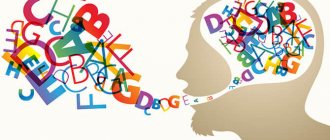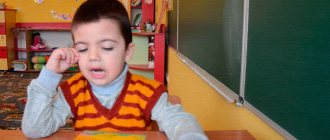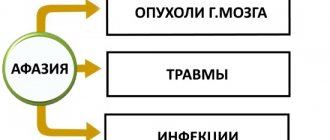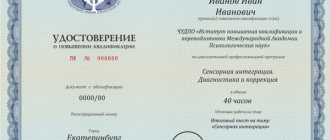Neurologist
SEMENOVA
Olga
5 years experience
neurologist, head of the office for diagnostics and treatment of cognitive disorders
Make an appointment
A disease in which a person experiences a decrease in verbal and logical thinking and other speech perception disorders are manifested is called sensory aphasia. Unlike other forms, sensory is considered mild; the patient is not able to perceive individual words and short phrases in all cases. A person with this type of disorder hears, but not as expected; words sound as if they are in another language. Against this background, anxiety intensifies, and disorientation in space is possible.
How does sensory aphasia occur?
The reasons for the loss of the ability to speak connectedly lie in damage to the cortex of the temporal lobe of the brain. This may be a consequence:
- traumatic brain injuries;
- epilepsy;
- cerebral aneurysms;
- tumors;
- infections - encephalitis, meningitis and other diseases affecting the brain and its membranes;
- abscesses that arise as complications of otitis media or for other reasons;
- severe diseases accompanied by neurodegeneration or demyelination of nerve fibers;
- stroke.
The last two causes are extremely rare in children, but, unfortunately, they cannot be completely excluded.
Advantages of visiting the Yusupov Hospital
Treatment of aphasia of various forms in Moscow is carried out by experienced specialists from the neurological department of the Yusupov Hospital. By trusting us with your health, you can be sure of receiving qualified medical care. Each patient is guaranteed an individual approach. In their work, doctors use proven modern techniques, which ensures a positive result of therapy.
Despite the high quality of services provided, prices are affordable (more details on the price list can be found on the website). In addition to neurology, services are available in other areas, including oncology, surgery, and therapy. For convenience, payment for treatment can be made in cash or by bank transfer. To make an appointment with a specialist, just call the numbers provided or fill out an application online, leaving your contact information.
Manifestations of the disease
The group of symptoms that manifests itself to a greater extent depends on which area of the brain is affected when sensory aphasia occurs. In any case, this is Wernicke’s area, where the speech analyzer is located, but the specific characteristics of sensory aphasia depend on whether the left or right hemisphere is affected: the perception or reproduction of speech is more impaired.
For a patient with sensory aphasia, words are just a collection of sounds. In some cases, recognition is partially preserved: the patient can identify the object shown to him as living or non-living, large or small. But he is unable to name the object itself. At the same time, the patient, as a rule, can perform simple actions on command - stand up, raise his hand, turn around. Without treatment, the disease progresses and leads to a complete misunderstanding of what is being said. Your own words are also not perceived as speech. Due to the lack of control by hearing, words become incoherent and are pronounced incorrectly and sometimes unrecognizable. Intonation also suffers. Pronunciation may be restored, but the construction of phrases will not appear on its own. Patients try to talk, and get angry when those around them do not understand them: a patient with sensory aphasia is sure that he speaks clearly.
Writing is also impaired to the same extent as speech. But the ability to read is lost only slightly - mainly due to confused stresses that distort the meaning of words.
Semantic aphasia. Examination and rehabilitation of patients
Cerebrovascular accident affecting the dominant hemisphere often leads to long-term impairment of cognitive and sensorimotor functions. In this case, it is practically important to answer the question: will the impaired functions be restored? However, in most cases, failure to recover during the first weeks or months after stroke carries a negative prognosis for subsequent recovery [10, 15]. However, in recent years, an increasing number of observations have been accumulating indicating the continuation of the recovery process years after a stroke. Given these data, there is a growing need to develop new methods for restoring speech and determining the long-term prognosis for patients who have suffered a stroke [4, 14]. The mechanisms involved in speech restoration in the acute period of stroke and in the long-term period are different. In the first days after the disaster, the recovery effect is due to the results of reperfusion therapy and restoration of neuronal function in the ischemic penumbra zone [5, 7]. The recovery process at later stages includes processes of compensation, based on the inclusion of additional areas of the brain, and reorganization (displacement of activity from the primary speech areas). This restorative potential of the brain is known as “neuroplasticity” [1, 8, 9]. Neuroplasticity is believed to be the basis of learning in both healthy and damaged brains. Moreover, under pathological conditions, the effectiveness of neuroplasticity processes depends on the degree of damage to those neural structures that may be involved in the recovery process. A recent meta-analysis of studies using functional magnetic resonance imaging (MRI) showed that when patients recover speech disorders, the process involves the remaining primary speech areas and new cortical areas of the left hemisphere, as well as areas of the right hemisphere homologous to the speech areas of the left . It has been found that in patients with aphasia, different areas of the cerebral cortex are activated and, therefore, different compensatory mechanisms are activated. Regional differences in the involvement and suppression of the activity of individual zones, as well as the degree of lateralization of brain activity, have been identified, which determines differences in recovery mechanisms depending on the location of the lesion [6, 12, 13, 16]. These data highlight the relevance of developing new approaches to improving diagnosis and restoring speech functions in patients with post-stroke aphasia.
Among the patients with the consequences of acute cerebrovascular accident and speech disorders who were treated in the neurological department of the State Budgetary Institution of Healthcare of the Moscow Region MONIKI named after. M.F. Vladimirsky, in some cases, during a speech therapy examination, the dominance of impressive speech disorders over expressive ones was revealed. These forms of aphasia are caused by the localization of the brain lesion in the posterior parts of the left hemisphere. At the same time, semantic aphasia occurs quite often, is distinguished by the severity of speech disorders and, unfortunately, by the low results of speech therapy correction [1, 3, 6]. The reasons for the low recovery results in posterior forms of aphasia are the lack of systematized recovery methods that take into account the structure of the cognitive defect, based on the results of modern research, and the lack of interaction between specialists (speech therapists and neurologists) involved in the rehabilitation of such patients.
If acoustic-gnostic (sensory) aphasia, which occurs with damage to the mid-posterior parts of the temporal region of the left hemisphere, and acoustic-mnestic aphasia, associated with suffering in the posterior third of the superior temporal gyrus and a primary decrease in the volume of auditory-verbal memory, are well known to neurologists, then semantic aphasia, which occurs with lesions in the parieto-temporo-occipital region are less easily diagnosed and fall out of sight of the neurologist.
Semantic aphasia is a component of the TPO syndrome (temporo-parieto-occipital syndrome), which occurs when the junction of the listed lobes of the left hemisphere of the brain is damaged. Here are located the tertiary fields of the second functional block (the block for receiving, processing and storing exteroceptive information according to A.R. Luria), which perform simultaneous (simultaneous) analysis and synthesis of multimodal information. Damage to the TPO zone manifests itself in disturbances in orientation in external space (especially right-left orientation), defects in the spatial orientation of movements and visual-spatial actions (constructive apraxia). Violation of the structural preconditions of thinking determines the uniqueness of the picture of speech disorders.
Clinical manifestations of semantic aphasia consist of impressive agrammatism (difficulty in understanding logical-grammatical phrases) and violations of semantics (understanding the deep meaning of a word). Speech disturbances are complemented by other manifestations of TPO syndrome: simultaneous agnosia (inability to understand the plot of a drawing or to compose a coherent plot from individual drawings), constructive apraxia (inability to form a whole from parts), spatial apraxia (impaired orientation in space), acalculia, which can be expressed as difficulty reading complex numbers and mathematical symbols, and the inability to perform counting operations.
Gradations of severity of semantic aphasia are determined conditionally and are associated with the severity of impressive agrammatism. It is believed that this syndrome can occur only in moderate and mild degrees of severity [2, 3]. However, we observed patients in whom this syndrome occurred in a severe degree of severity, which was expressed in a violation of visual object gnosis, a gross violation of visual-spatial perception, acalculia, apractagnosia, and inability to understand the simplest prepositional case constructions.
We present a clinical case of a patient with severe semantic aphasia and rehabilitation methods used in the neurological department of the State Budgetary Institution of Healthcare of the Moscow Region "MONIKI named after. M.F. Vladimirsky."
Patient P. suffered an ischemic stroke in the territory of the left middle cerebral artery, as a result of which he developed right-sided hemiparesis with a decrease in strength to 3 points in the muscles of the arm and 4 in the legs and speech disorders. MRI of the brain revealed massive damage to the junction of the occipital, parietal and temporal lobes of the left hemisphere (Fig. 1).
The syndrome manifested itself in the following aspects: impaired visual perception; impairment of visual-spatial perception (Fig. 2); difficulties when performing counting operations (Fig. 3); difficulties in time orientation (Fig. 4) and inaccessibility to understanding prepositional-case constructions.
A violation of right-left orientation was detected when asked to identify the corresponding part of the body in the picture (Fig. 5).
To confirm the connection between a pronounced impairment of visual-spatial perception and the disintegration of the meaning of a word, the patient was shown a text written in a vertical direction with the aim of translating it into a horizontal direction. This task caused great difficulty for the patient (Fig. 6).
At the same time, he had no changes in auditory speech gnosis, there was no narrowing of the volume of auditory-speech memory (memorization of up to 6 words and their subsequent delayed reproduction was possible), motor difficulties were noted.
Rehabilitation work with the patient was carried out taking into account the severity of the syndrome. Therefore, at this stage, a bypass recovery path was used, which consisted of attracting the preserved capabilities of the subdominant hemisphere and preparing for stimulation of the depressed dominant hemisphere.
The restoration technique was divided into three stages. At the first stage, visual gnosis was corrected. Difficulties in naming objects were overcome using the following methodological techniques: differentiation of object pictures (Fig. 7), perception of stylized images and correlation of unfinished objects with the model.
At the second stage, work was carried out to restore the understanding of mathematical signs and simple mathematical operations using techniques for differentiating numbers and solving mathematical problems by comparing them (Fig. 8). At the third stage, the central task of rehabilitation was the restoration of spatial perception. The patient was offered the following methodological techniques: analysis of the body diagram in the picture with transfer to himself, showing object pictures, working with objects in the room. In order to prepare for the restoration of speech semantics with an average severity of the syndrome at this stage of rehabilitation, the patient was offered a text written in a vertical direction to be translated into a horizontal direction.
As a result, during a two-week course of rehabilitation work, it was possible to overcome the severe degree of severity and achieve a clinical picture of moderate severity in the patient. It was expressed in typical speech errors: mild visual-spatial difficulties, as well as when performing complex counting operations, difficulties in understanding logical-grammatical phrases and difficulties in understanding the figurative meaning of a word.
Thus, despite the relatively short period of training, 2/3 of the patients achieved good results. The key to achieving such recovery results was an integrated approach to the rehabilitation of patients with the consequences of a stroke.
How does sensory aphasia occur in childhood?
Sensory aphasia in children occurs quickly, but after eliminating the factor that damaged the brain, speech is also quickly restored, because it is easy for the child’s brain to develop new connections to replace the lost ones. It is worse if speech has not been restored several weeks after the event that led to its loss. In this case, the forecast becomes worse.
When diagnosing children, it is easy to confuse aphasia (loss of speech skills) with alalia (their immaturity). Anamnesis will help to distinguish between the conditions: were there any traumatic factors at what stage of the child’s development before them?
Diagnosis and treatment methods for aphasia in Moscow
The problem can be resolved with the help of qualified specialists. The disease requires elimination of the main cause and further correction. The speed of its correction largely depends on the degree of brain damage, so it is important not to delay a visit to a specialist. Diagnosis and treatment of speech disorders is carried out by specialists from the Department of Neurology.
At the initial appointment, the doctor collects anamnesis, collects complaints (in the case of aphasia, if it is impossible to independently describe the condition, close relatives are involved in the diagnosis), conducts a general examination for the presence of external abnormalities (in particular, drooping corners of the lips, decreased tone of the limbs).
Additionally, an examination by a neurologist in a team with a speech pathologist-speech pathologist is required so that the nature of the disorder can be assessed and appropriate corrective measures can be selected. Initiation of therapy requires testing, including assessment of the following symptoms:
- Spontaneous speech. Speech is assessed by the number of words spoken, the presence of spontaneous errors, and the frequency of pauses to select suitable words.
- Understanding. The patient is asked to point to objects that the specialist names and answer basic questions (“yes” or “no”).
- Enumeration of objects. The patient is asked to say the name of the specific object that the specialist points to.
- Reading and writing. The patient is given the task of writing any phrase and saying it out loud. This allows you to assess the degree of understanding and pronunciation.
- Semantic activity. The doctor demands to name all the animals that the patient remembers in one minute.
What is sensory aphasia?
Experts distinguish the following types of sensory aphasia:
- semantic: the patient does not understand how words and objects relate; first of all, the perception of their spatial arrangement suffers;
- acalculia - there are difficulties with mental calculation;
- sensory-motor - the patient poorly understands/does not understand the spoken speech and at the same time is not able to articulate correctly;
- total - gross violations of both oral and written speech - both understanding and reproduction.
Read also
Neurogenic bladder
In a healthy person, the process of urination is carried out in the form of a voluntary reflex act, and we can control it.
However, this is not the case with this disease. Patients are extremely... Read more
Sudden memory loss/transient global ischemia
Transient, that is, temporary memory loss occurs in elderly patients and people suffering from migraines. At the same time, memory for past and present events disappears. But the person is conscious, accessible...
More details
Fainting
The term “fainting” (syncope, syncope) comes from the Greek word syncope, which means “to interrupt”, “to turn off”. Fainting is a spontaneous loss of consciousness with a rapid onset associated with a decrease in...
More details
Pelvic pain
Pelvic pain is pain in the muscles that form the pelvic floor and organs located in the small pelvis, caused by microtrauma, chronic deformation of the sacrococcygeal region due to anatomical…
More details
Intracranial hypertension on MRI
Intracranial hypertension is an increase in intracranial pressure. Normal intracranial pressure is 15 mm Hg. When blood pressure doubles, a stroke occurs. At a pressure of 50 mm Hg, the patient can...
More details
How to recognize the disease?
Sensory aphasia syndrome has an important feature: this disease does not arise out of the blue, there must be a reason. The patient himself may not know about it, not attach importance to it, or, due to a speech disorder, may not be able to talk about it. Therefore, modern research methods come to the rescue: computer (CT) and magnetic resonance (MRI) tomography, electroencephalography, and, if necessary, contrast angiography, which will help identify vascular pathologies.
In fact, sensory aphasia is a symptom of deeper disorders. But often, after eliminating the causes, speech is not restored immediately. This happens when the cortex of the speech centers is destroyed irreversibly, and it takes time for other parts of the brain to take over the functions of this area. When doctors are convinced that there is no danger to the patient’s life and health, it is time for rehabilitation: these classes are designed to speed up the process of formation of new neural connections.
Diagnostics
Diagnosis of aphasia lies in the competence of speech therapists, neuropsychologists and neurologists. The following studies may be prescribed:
- computed tomography of the brain
- magnetic resonance imaging of the brain
- lumbar puncture
- duplex scanning of cerebral vessels
- Doppler ultrasound of head and neck vessels
- magnetic resonance angiography
The following examinations should be carried out if aphasia is suspected:
- letter diagnostics
- diagnostics of oral speech (impressive and expressive)
- auditory-verbal memory test
- motor memory test
- diagnostics of the state of visual memory
They also carry out diagnostics:
- intelligence
- constructive-spatial activities
- visual gnosis
- praxis (dynamic, somato-spatial, finger, hand, facial, oral)
Differential diagnosis of aphasia with the following diseases is required
- mental retardation
- hearing loss
- dysarthria
- children's alalia
Bringing speech back
Correction of sensory aphasia primarily includes drug support - continued treatment of the disease that led to the speech disorder. The primary treating physician for such patients is a neurologist. Its task is not only to monitor the continuation of treatment, but also to monitor whether other neurological disorders develop, which may either be a consequence of a previous illness or injury, or arise for other reasons. The doctor decides which medications are used individually in each case. If you want to add something to your treatment (most often you want to add vitamins), be sure to discuss this with your doctor! Accurate implementation of the neurologist’s prescriptions is the basis for success in speech rehabilitation.
An important component of treating sensory aphasia is working with a speech therapist. It happens, especially in children, that speech is restored on its own, but no one can predict whether this will happen or not. Therefore, remedial training for sensory aphasia is an essential part of therapy. The speech therapist will teach parents what exercises to do at home and what to watch for so that rehabilitation goes faster and more successfully. The main task of relatives is to organize a comfortable environment for the patient and learn to communicate with him. The exercises that the speech therapist asks you to do at home will help with this. Don’t force things, the brain needs time to restore neural connections. It is extremely important to dose the load; overwork will not benefit the baby.
Our center’s specialists have extensive experience in restoring lost speech in children. They are familiar with methods that are recognized as effective by the global speech therapy community, and choose from a variety of methods those that will work best for a particular child. We achieve results whenever this is possible in principle - and in children it is possible to restore lost speech in most cases.
Treatment methods
The form and cause of aphasia determines treatment tactics. Initially, they try to influence the cause of the disease, for example, oncology, inflammation, changes in cerebral circulation. You need to understand that with aphasia, speech restoration takes a long period and requires a competent approach. Complex therapy includes both medication, physiotherapeutic treatment, and speech therapy. Only under these conditions is it possible to provide high-quality correction of the patient’s speech disorders.
Dialogical work
Our main work in the correction of aphasia is dialogic speech.
Scheme of work in this direction:
- the patient repeats the prepared answer phrase;
- the speech therapist prompts the first one or two syllables, and the patient must complete the word or phrase;
- the patient must select one or more words from those spoken by the speech therapist;
- the patient must answer the speech therapist’s question without prompting.
Remember, aphasia is treatable. If in adults the recovery process is difficult and takes a lot of time, then in children aphasia is treated quite quickly and effectively. The use of effective techniques, songs, and negotiation exercises significantly accelerates the patient’s process of developing coherent speech.
Our speech pathologists and speech pathologists conduct speech therapy classes in Almaty for the correction of aphasia in both adults and children. If you need help or advice, please contact us!
Motor cortical aphasia (Broca), verbal, expressive aphasia
Motor cortical aphasia is characterized by impairment of oral speech, writing, and reading. Motor cortical aphasia occurs when the posterior parts of the inferior frontal gyrus of the dominant hemisphere are damaged. In mild forms, speech is slow, ungrammatical, the construction of phrases is impaired, and the set of words is reduced. Synonyms for motor cortical aphasia are Broca's aphasia, verbal aphasia, and expressive aphasia. With severe disorders, patients use only a few words or syllables (speech embolus) to express various shades of their emotions.
Disinhibition of speech at the initial stages of aphasia development
The most effective method of eliminating aphasia and preventing the problem from worsening is to bring speech sequences to an automatic level by performing exercises such as singing, repeating phrases, finishing sentences, tongue twisters, etc.
When disinhibiting, the speech therapist completely pronounces the sentence to the last word, pronouncing only one syllable. The patient’s task is to finish the last word. First, the speech therapist examines the patient, determines what is easier for the patient, verbs, nouns, adjectives.
For example: the goat bleats, and the dog ... (barks); grass in the yard, firewood on the grass); Summer, sun, ... (heat); take matches, light... (fire).
Also, when disinhibiting, it is possible to achieve very good results using sayings. For example: you can’t even pull a fish out of ... (pond) without difficulty.
If such exercises cause difficulties for the patient, and more often than not, the song helps. The speech therapist begins to sing and when the patient begins to recognize the song, a smile spreads across his face.







